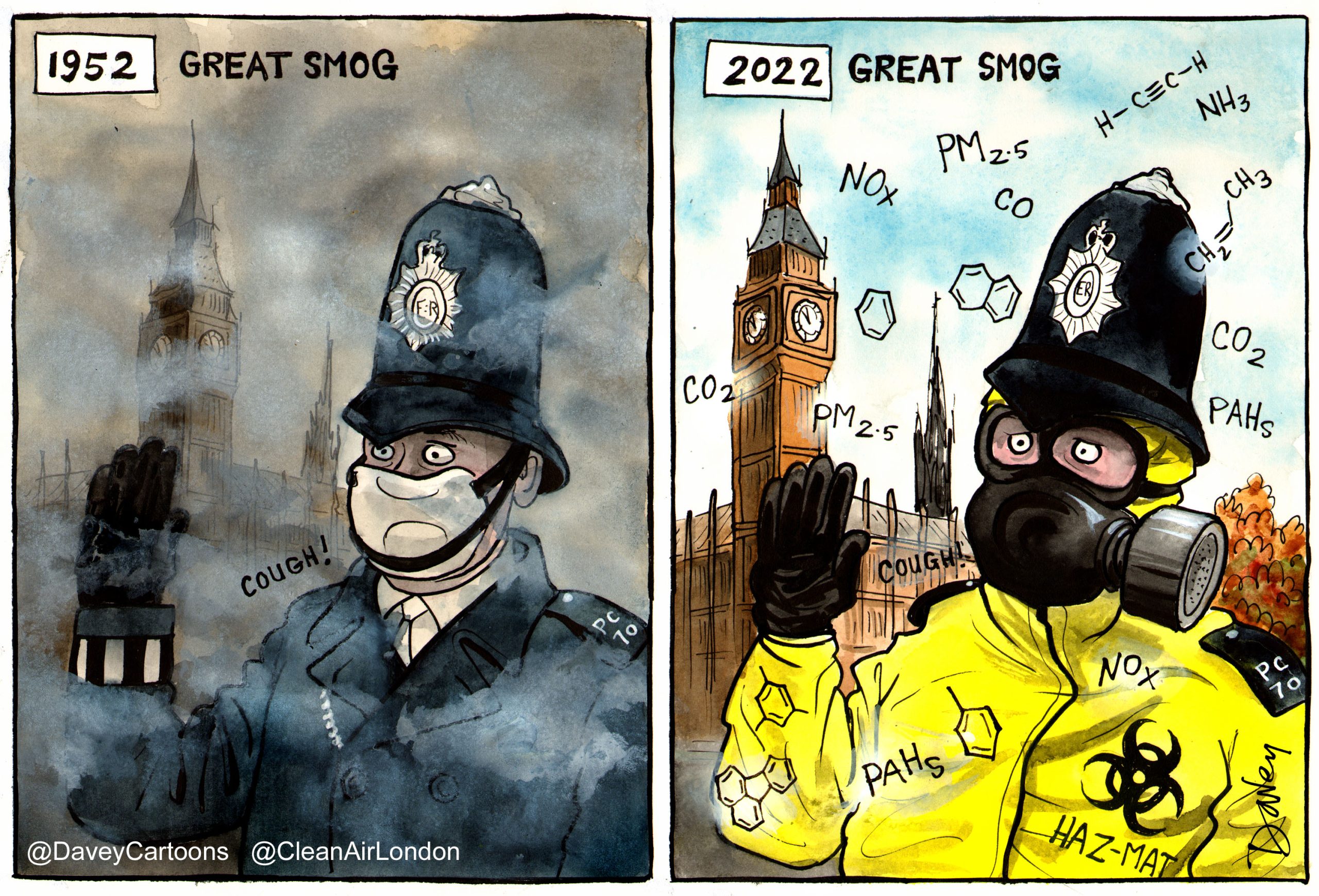#ULEZ and #TCharge are important steps on the path to banning carcinogenic diesel fumes in London.
But Mayor Khan must take bigger, stronger and smarter steps to keep his manifesto pledge to ‘restore London’s air quality to legal and safe levels’.
The Emissions Surcharge (T-Charge or #TCharge) commenced in London at 7.00am on Monday 23 October 2017. It is the first significant measure to address traffic congestion or air pollution to be proposed and implemented in London since the Congestion Charge and Low Emission Zone were established by Mayor Ken Livingstone (Labour) between 2003 and February 2008.
On 3 November 2017, Mayor Khan confirmed that the Ultra Low Emission Zone (ULEZ or #ULEZ) will commence on 8 April 2019. Mayor Johnson had proposed that it would be implemented by the next Mayor in September 2020.
Quotes
Simon Birkett, Founder and Director of Clean Air in London (CAL), said:
“Good news! The #ULEZ and #TCharge are important steps on the path to banning carcinogenic diesel fumes in London. Furthermore:
- “Diesel is the devil and must be banned from cities and large towns. It has been a public health catastrophe for Europe. The important questions are which vehicles, when, where and how?”
- “Mayor Sadiq Khan needs to do much more to deliver on his manifesto pledge to ‘restore air quality in London to safe and legal levels’. Central Government must stop sitting on its hands and help him. The most vulnerable people don’t have cars, just pollution.”
- “The Mayor must take bigger, stronger and smarter steps to reduce air pollution from traffic. We need him to: include the whole of inner London by January 2020 and the rest of London soon afterwards; ban the most-polluting vehicles, not charge them; and introduce Emissions Based Road Charging (Pollution Charging or EBRC) that would be fairer and simpler.”
- “Emissions Based Road Charging should replace the chaos of four blunt schemes (Congestion Charging, T-Charging, Ultra Low Emission Zone and Low Emission Zone) with one simple scheme that would calculate a single charge based on: location (inner or outer London); time of day (e.g. morning or evening rush hour or not); quality of fuel (e.g. diesel or zero tailpipe emissions); and quantity of fuel burnt. It would be simpler and fairer by charging people much less to drive short distances in smaller, cleaner vehicles in quiet periods.”
- “Diesel vehicles are responsible for about 90% of the most harmful exhaust emissions in London. An investigation by CAL found that Maggie Thatcher was the first Prime Minister to promote diesel vehicles and this catastrophic policy has been pursued by every government since. Worse, John Vidal, former Environment Editor of the Guardian, found that policy makers knew they would be killing people in cities in their pursuit of possible carbon dioxide savings. Instead we must think ‘One Atmosphere’ and address greenhouse gases and local air pollution together.”
- “Importantly, the T-Charge seems to be contributing to the collapse of diesel sales nationally with diesel car sales falling 22% in September 2017. With the Mayor including petrol vehicles alongside diesel in the #TCharge, we are seeing car buyers moving quickly from fossil fuel vehicles towards electrics and hybrids.”
- “CAL urges the Mayor to be keep up the momentum and other cities to follow him by banning carcinogenic diesel fumes from our streets and encouraging people into walking, cycling, public transport and cleaner vehicles. We also need measures to encourage waste, freight, construction and delivery consolidation and create a widespread electric charging infrastructure. Where is the Government in this crisis that it helped create?”
- “Today is a landmark for clean air campaigners. We urge Sadiq Khan to make the #ULEZ bigger, stronger and smarter by January 2020.”
“Let’s take the opportunity to re-engineer London and make it a world leader as we did so successfully when we banned coal and wood burning with the Clean Air Act in 1956.”
Lively interview with Simon McCoy on BBC World News’ #AfternoonLive on 23 October 2017 about the #TCharge and banning diesel (total length 4 minutes 10 seconds):
Lively interview with @BBCSimonMcCoy #AfternoonLive about #TCharge and banning diesel pic.twitter.com/hGhohHjMju
— Clean Air in London (@CleanAirLondon) October 24, 2017
Notes
- #ULEZ and #TCharge details – note that it is an ‘emissions surcharge’ so requires no new ‘signage’
https://tfl.gov.uk/modes/driving/ultra-low-emission-zone
https://tfl.gov.uk/modes/driving/emissions-surcharge
- Sadiq Khan’s manifesto
https://cleanair.london/app/uploads/CAL-332_Sadiq_Khan_Manifesto-0316-1.pdf
- Mayor Boris Johnson
Mayor Boris Johnson took backward steps on traffic measures during his Mayoralty that included delaying Phase 3 of Ken Livingstone’s Low Emission Zone before implementing it with the planned Phase 4. Boris proposed an Ultra Low Emission Zone to be implemented by the next Mayor but one (i.e. September 2020) after numerous delays and decisions to weaken it.
4. Health impacts of air pollution (including PM5 and NO2)
https://cleanair.london/clean-air-in-cities/
http://www.iarc.fr/en/media-centre/pr/2012/pdfs/pr213_E.pdf
https://www.london.gov.uk/press-releases/mayoral/every-londoner-is-exposed-to-dangerous-toxic-air
- Emissions Based Road Charging
Emissions-based charging by 2018 and paid to walk or cycle by 2020
- Blame Maggie Thatcher and every government since for promoting diesel
http://www.telegraph.co.uk/business/2017/10/05/new-car-sales-decline-9pc-diesels-fall-favour/
- Action by world cities
https://www.theguardian.com/cities/2017/apr/13/death-of-diesel-wonder-fuel-new-asbestos
- London Air Quality Network monitors
Brompton Road (Knightsbridge): Nitrogen dioxide (NO2) annual mean YTD 65 ug/m3.
Upper Thames Street (Walbrook Wharf): Nitrogen dioxide (NO2) annual mean YTD 92 ug/m3










